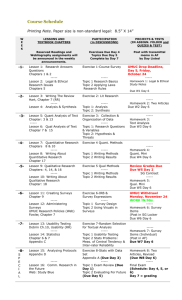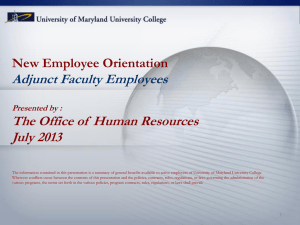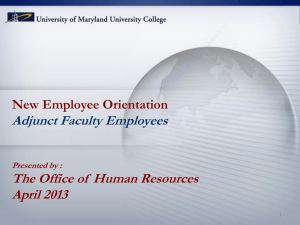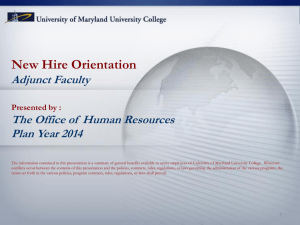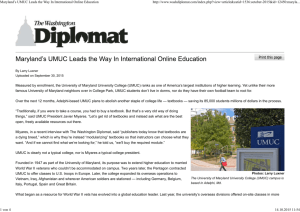Circuit-riding students and professors
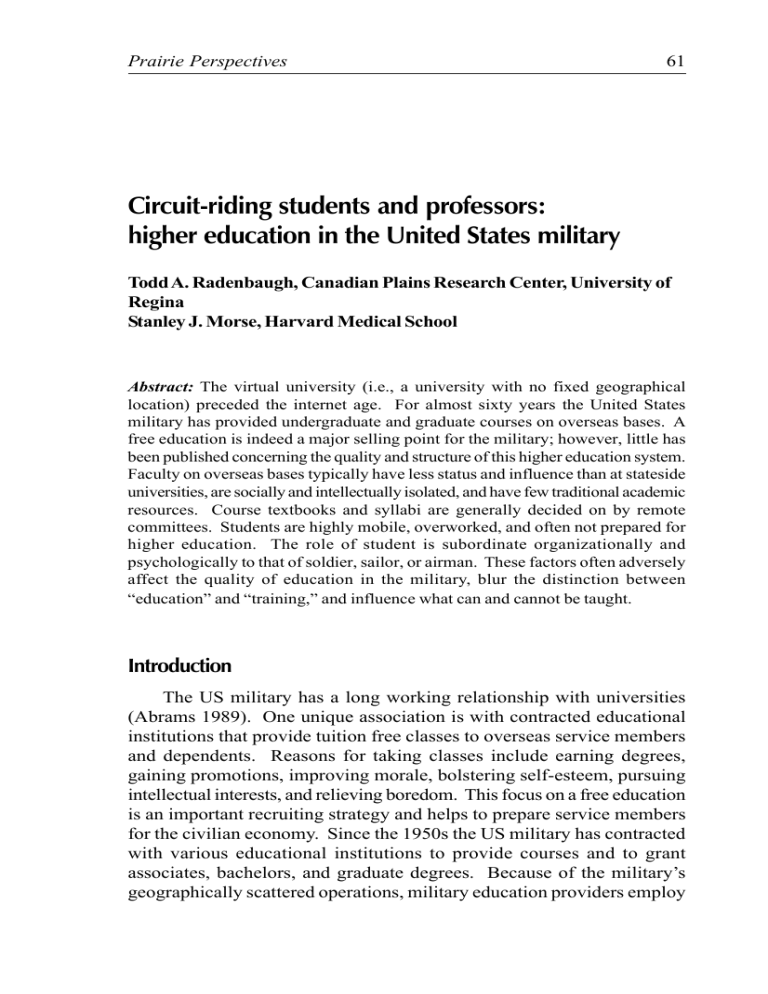
Prairie Perspectives 61
Circuit-riding
s
tudents and
p
rofessors:
hi
gher
e
ducation in the United States
m
ilitary
Todd A. Radenbaugh, Canadian Plains Research Center, University of
Regina
Stanley J. Morse, Harvard Medical School
Abstract: The virtual university (i.e., a university with no fixed geographical location) preceded the internet age. For almost sixty years the United States military has provided undergraduate and graduate courses on overseas bases. A free education is indeed a major selling point for the military; however, little has been published concerning the quality and structure of this higher education system.
Faculty on overseas bases typically have less status and influence than at stateside universities, are socially and intellectually isolated, and have few traditional academic resources. Course textbooks and syllabi are generally decided on by remote committees. Students are highly mobile, overworked, and often not prepared for higher education. The role of student is subordinate organizationally and psychologically to that of soldier, sailor, or airman. These factors often adversely affect the quality of education in the military, blur the distinction between
“education” and “training,” and influence what can and cannot be taught.
Introduction
The US military has a long working relationship with universities
(Abrams 1989). One unique association is with contracted educational institutions that provide tuition free classes to overseas service members and dependents. Reasons for taking classes include earning degrees, gaining promotions, improving morale, bolstering self-esteem, pursuing intellectual interests, and relieving boredom. This focus on a free education is an important recruiting strategy and helps to prepare service members for the civilian economy. Since the 1950s the US military has contracted with various educational institutions to provide courses and to grant associates, bachelors, and graduate degrees. Because of the military’s geographically scattered operations, military education providers employ
62 Prairie Perspectives a faculty with diverse backgrounds, including full-time and adjunct faculty who live in countries hosting bases, traveling faculty, and distance education faculty.
Operating an accredited, worldwide university that provides a quality education meeting both the needs of students and the military is a daunting endeavor. With no permanent campus and few local staff the issues faculty face are not usually encountered in standard educational institutions: students deployed or reassigned, canceled or relocated classes, and poor maintenance of AV and other essential equipment. Near active deployment zones, classes usually are also conducted under tight security, with no or limited access to off-base services. One of the most challenging issues facing faculty who teach courses for military personnel is the wide array of educational backgrounds and interests that students bring to the classroom.
Although a high school diploma is the minimum standard for acceptance, many students have rudimentary writing, math, and study skills. Further, as most are full time service members, their main focus is not on coursework or student activities.
Curiously, there are few recent descriptions of how higher education on overseas US bases operates. Hays (2003) discusses teaching psychology and English courses on a ship in the Persian Gulf. This is in sharp contrast to numerous examinations of higher education for officers
(e.g., Kennedy and Neilson 2002; Stiehm 2002) and of specific officer training programs (e.g.: Garraway 2002; Schumm et al. 2003) and pleas from within the military for increased educational opportunities for enlisted personnel (Kime 2004; Murphy 2003).
Most face-to-face and distance education courses are currently provided by University of Maryland University College (UMUC), an adult education component of the University System of Maryland. In 2004,
UMUC had 50,234 students in face-to-face classes on bases in 23 countries outside the U.S. and 126,341 enrolments for online courses (see http:// www.umuc.edu/ip/umucfacts_02.html). While UMUC’s headquarters are in Adelphi, Maryland, overseas programs are largely administered from
Heidelberg, Germany (Europe and the Middle East) and Tokyo, Japan
(Asia). Other contracted education providers include Embry Riddle
Aeronautical University, Central Texas College, University of Oklahoma,
University of Phoenix, and Troy State University.
To investigate UMUC’s current efforts to provide quality university education, Radenbaugh (an earth and environmental scientist) and Morse
(a psychologist) draw upon their experiences working for UMUC on military bases in Belgium, Germany, Italy, Kosovo, Kuwait, and Turkey and upon the experiences of fellow faculty members. This paper discusses how this
Prairie Perspectives 63 educational system works and compares the military’s notion of education with that of a typical U.S.-based undergraduate institution.
Case Study — University of Maryland University College
The UMUC started in 1920 as the College of Special and Continuation
Studies in Adult Education, offering evening courses in Maryland. In
1947 the college became part of the University of Maryland system and, under a U.S. Department of Defense contract, expanded into six European locations. In 1956 it began programs in Asia and was renamed “University of Maryland University College.”
Despite its large enrollment, UMUC has no “campus,” except for a combination office building, hotel, and conference center in Adelphi,
Maryland. Classes are usually offered in other institutions’ classrooms
(overseas, mostly in the classrooms of the base Education Center). This lack of campus provides only limited opportunity for students to experience a typical academic environment, to participate in extracurricular activities, or to have ready access to such facilities as a research library. It also does not allow participants to feel part of an academic, let alone scholarly, community. To promote an academic atmosphere faculty must thus make extra efforts to hold discussions, study sessions and workshops for students.
Given its focus on non-traditional students, UMUC emphasizes practical and career-related skills. The most popular degrees awarded are in communications, computer science, history, legal studies, and the social science, but UMUC offers Bachelors degrees in five arts and nineteen science fields (UMUC 2004). At the Masters level, UMUC offers a number of “executive programs,” including an MBA and certificates in counseling, technology management, information technology, and public administration. The school also provides many short courses such as three to five-day business and leadership seminars.
The learning environment:
In 2004, about 70% of the courses offered at UMUC took place in traditional classroom settings. However, distance or online education is booming (Noble 2001), and military providers are part of this trend (Heeger
2000; Patterson Lorenzetti 2004). The likely result is a decrease in face-toface courses (particularly at small, geographically isolated, potentially dangerous, locations) and in the number of overseas faculty.
64 Prairie Perspectives
The military generally has the responsibility of providing and maintaining classroom space, which is a significant cost saving for education providers. The quality of classrooms thus varies widely, as does the availability of audio-visual and other educational aids. Further, courses that require a lab, such as geography, biology, chemistry, and geology, become problematic because there are rarely adequate facilities or necessary equipment. Library services at most military instillations are restricted to small base libraries with few academic resources. To supplement this, UMUC offers a standard set of online research databases.
However, effective use of these databases is challenging. Since classes are usually only eight weeks long and enrollment is a complex, lengthy activity, students may not have access to the databases until well into the semester. While a student can request the mailing of books and articles from the University System of Maryland library system, this will normally take longer than six weeks. Material is unlikely to arrive before the end of the semester.
The shortage of labs and libraries makes access to the internet vital.
Although UMUC has computer labs at most military instillations where it holds classes, the times they are open and the quality of equipment vary greatly. For example, in Brussels (NATO) and Kosovo (Camp Bondsteel) the UMUC computer lab was well maintained and well run while in Kuwait, one base had a small computer lab that was only open on weekdays between 5 pm and 8 pm, if a lab supervisor was available and no classes were scheduled. On another, newer and larger base in Kuwait, the computer lab had not yet opened even though courses were being offered. At the
Incirlik Education Center in Turkey, students could not use the UMUC computer lab outside of class because of unspecified security concerns.
To develop library skills, students take a special course. This course is supposed to be taken early in a student’s program, but is often not available when it should be taken. When available, it requires considerable work for only one academic credit. Many students therefore avoid taking this course until they are almost finished with their degrees. Although this course often provides valuable information, it is usually taught entirely in the computer lab (with no visit to the library) by an English teacher who often is unfamiliar with databases in other fields. It is therefore not surprising that most students lack minimal skills in using libraries and online databases.
Educational quality:
In traditional universities, faculty and administers have at least the potential of working together to assure a quality education (hopefully in a cooperative endeavor). Administrators are responsible for ensuring that
Prairie Perspectives 65 the institution runs efficiently and effectively in terms of enrollment and finances. Faculty members are accountable for the curriculum and the quality of the program and courses within their disciplines. Forces outside these two constituencies usually do not play any formal role in the process.
A core faculty is usually non-existent in overseas military education because of geographical dispersion, high turnover, and very limited communication among persons within the same academic discipline. To compensate for this, military education providers allow (and may require) the administration (with perhaps some perfunctory faculty consultation) the final say in the curriculum and the choice of textbooks. At present, faculty members are given standard syllabi. Changes must be approved by the academic director of the discipline in question. This supposedly guarantees standardization of course content and ensures that syllabi will be available (on the web) before registration. Faculty then must often endorse or stand behind impenetrable, jargon-filled syllabi at times replete with spelling and grammatical errors or tell students to ignore the online syllabi.
As a whole, UMUC faculty members in Europe and Asia have less formal education than faculty at other Maryland universities. Comparison with the University of Maryland in College Park is salient because many students believe that they will receive degrees from this institution since they do not distinguish between UMUC and College Park. This is a distinction that UMUC personnel have a clear incentive to blur, as in advertisements and literature that depict UMUC as “Maryland in Europe.”
Table 1: Highest degree earned by instructional staff at UMUC by region.
Source: UMUC Factbook, 2003
66 Prairie Perspectives
Even comparing UMUC overseas and stateside faculty is instructive. As
Table 1 shows, there were about 18% more faculty with Ph.D.s stateside than overseas in 2002-2003. Over 50% of overseas classes were taught by faculty with a Masters degree or less. Scholarly productivity is also lower among UMUC overseas faculty, as UMUC does not provide funding or opportunities for research and indeed often discourages research on military bases.
One possible indicator of educational quality, or at least of the effective use of educational resources, is graduation rates. Not surprisingly, overseas graduation rates are low: 13% for UMUC and 7% for the
University of Phoenix, which offers only online courses (US News and
World Report 2004). These figures are well below other US educational institutions (Table 2). Table 3 compares the ratio of students enrolled at
UMUC in a given year with the total number receiving degrees in that year.
Assuming that an average student takes four to five years to receive a
Bachelors degree and two to three years to receive a Masters degree, the expected ratio should be below five for a Bachelors degree and three for a graduate degree. However, while the UMUC stateside program comes close to this ratio, the average for both UMUC’s European and Asian programs is over thirteen. There are good reasons for this. Changing priorities, duty stations, and needs of their service interrupt courses. Most service members in a one-year overseas tour take one or two classes per term and earn less than one year of college credit (Rubin 1997; Chernitzer
2003).
A low graduation rate may trivialize education and undermine academic quality. Complaints by faculty concerning the quality of some courses and concerning student performance and expectations are, for example,
Table 2: Comparisons of universities using US News and World Report indicators.
Prairie Perspectives 67
Table 3: UMUC graduates degree level and division - ratio of enrolled students
(headcount) to graduates in given year.
often dismissed by administrators with the comment that this issue is not of major importance because most students will take only one or two courses and are not expected to graduate.
Idiosyncrasies:
A major influence on the local quality of military higher education is the staff of the base education center, who often interprets the purpose and nature of higher education differently than do academic faculty. This staff includes administrators, trainers, counselors, and testers as well as one or more “field representatives” from the education providers. Staff often chose to have limited contact with teaching faculty. The number of center personnel can range from one part-time person at small bases to over 20 at the largest. All of these people are under the supervision of the
Educational Services Officer (ESO), a civilian employee of the Department of Defense. The ESO’s relationship with university staff, including instructors, is important. Each ESO has different rules. An effort to inform faculty of these rules is necessary for a successful learning atmosphere.
The success in teaching and learning on military bases (and on selfesteem and feeling of psychological comfort and utility) largely depends on the local staff’s understanding of, and commitment to, education. This is not the same as commitment to maintaining satisfactory statistics on course and enrollments courses offered, although seemingly mistaken for such by many administrators. Field representatives and other base personnel in effect serve as local deans, department chairs, bursar, and academic advisors. Personal agendas and relationships (about which distant administrators and traveling instructors normally know little and care even less) may thus largely determine what faculty can and can’t do and what students are likely to expect and actually encounter.
68 Prairie Perspectives
Good relationships are not always maintained between ESOs and education providers. For example, we found that the Spangdalham
Education Center (in Germany) ran efficiently with education in mind.
However the Incirlik Education Center (in Turkey) did not foster a good learning environment. The quality of classes at each location was therefore not the same, even though the instructors were. Another issue concerns staff members that are actively pursuing their own degrees through UMUC.
This creates inherent conflicts of interest and boundary problems between instructors and field representatives. In a particular class, for example, the field representative may see his or her role as a representative of the students, as an agent of the instructor, or as in some ways the instructor’s boss. We have seen field representatives deciding what classes will be offered based upon their own degree needs rather than upon student needs, faculty availability, and overall curriculum considerations.
Course modularization:
Standardization of curricula and courses raises the risk of courses becoming too modularized. Such a path limits the faculty’s ability to respond to varying educational backgrounds. Perley and Tanguay (1999) argue that modularization threatens three defining features of universities: academic freedom; collegial governance; and the presence of scholars and students engaged not only in teaching and learning, but in advancing knowledge. Risk of modularization is a major concern for distance education programs.
Controversial topics:
Many students come from small towns in the South and Great Plains states, where religious and political views tend to be more conservative than elsewhere in the country. This creates a situation where they may feel threatened by the views of fellow students from more cosmopolitan backgrounds. It also may reinforce the psychological and intellectual distance between students and professors, assuming that most faculty are more critical and less tied to prevailing religious and political viewpoints than are these particular students (which is, of course, not always the case).
Education providers want to appeal to as many students as possible as tuition is reportedly their only source of income. Complimenting this, the military wants statistics showing that many service members are actively and successfully pursuing higher education. While the military may want to foster learning, self-development, and critical thinking, these outcomes may conflict with the need to retain enlisted personnel and to
Prairie Perspectives 69 guarantee discipline and order in the ranks. This creates an inherent difficulty for faculty who encourage thinking about viewpoints some students may find novel, alien, or even distasteful (Mednicoff 2003). In a multifaceted but generally conservative and authoritarian setting such as the military, it can be difficult to encourage and reward critical thinking and tolerate unconventional or unpopular ideas. Three persistent ideas present inherent difficulties: (a) the Theory of Evolution, (b) the notion that homosexuality is not a matter of free choice, and (c) the idea that different people can legitimately behave and think differently; one culture is inherently no better than another (i.e., cultural relativity).
Cultural relativity may easily jar one’s self-assurance and commitment to policies believed to be morally ‘right’ simply because they are endorsed by political or military authorities and because most of one’s peers may have similar views. It is, of course, possible to steer clear of discussions touching on cultural relativism unless one teaches anthropology or sociology. With more difficulty sexual orientation may be avoided, even in a course on interpersonal relationships (where it should be discussed).
The teaching of evolutionary theory poses perhaps greater difficulties because it is essential to understanding biology and geology. Although there is no explicit military policy against teaching evolution (and thereby not endorsing Creationism), the military actively encourages the teaching of many sacred scriptures and promotes a religious worldview. We need look no further than the conspicuous role of base chaplains as religious advisors as well as counselors, therapists, and mentors to understand the influence exerted by traditional religious belief systems. While systems of traditional (usually Christian) religious beliefs and practices may provide comfort to soldiers in hostile locations, the suppression of contrary ideas would not be tolerated at secular universities.
Conclusions
University courses on military bases overseas offer many positive benefits to service members and dependents. Education providers supply needed courses at overseas bases, including isolated locations like the
Balkans and the Middle East, an accomplishment that is appreciated by service members. There are however always ways to improve the student experience. It is difficult to maximize student learning on U.S. military bases because of structural constraints that include poor libraries, syllabi prepared by faceless committees, time constraints, generally poor academic skills, lack of continuity in instructors and offerings, and vague and
70 Prairie Perspectives incompatible goals on the parts of all participants. While many faculty members try to promote critical thinking, facilitate inter-cultural understanding, and teach the latest developments in their fields, education administrators often want the educational enterprise to maintain a low profile in order to reduce conflict and guarantee renewal of the university’s contract with the military. As in other educational institutions faculty and educational administrators are often at odds about how to educate. But the military education system gives most decision-making power to administrators. This power stems from contracts which equate quality with statistics on the number of students enrolled, with the date by which a syllabus should be posted on a web site, by the number of courses to be offered per term, and so on. This leads to a ‘by any means necessary’ mentality. Faculty who equate quality with student learning rather than with bureaucratic outcomes, who ask for more faculty involvement in decision-making, or who criticize current textbooks and other curricular materials are often encouraged to quit or their contracts are not renewed.
The result seems to be an increasingly passive, disinterested, out-of-date teaching faculty with ever lower credentials.
Although the military is concerned about the quality of education and is watchful of enrollment in courses from unaccredited “diploma mills”
(Robson 2004), it needs to also remain vigilant of its contract institutions.
Many of these issues are summed up by an anonymous student/airman:
“...While they may not be diploma mills as some schools are, I do feel they push too many students through who do not meet current standards.” Incirlik Turkey 9/2004.
“They” refers to UMUC and other contract providers of higher education to the military.
So how can the military improve its higher education system? First education providers need to hire and retain (for more than one year) qualified faculty with Ph.D.s and interests in both scholarship and student learning. A reduction in the number of transient faculty will strengthen academic standards. Faculty members with extended experience interacting with enlisted personnel will have better appreciation of how they live and the problems they face, leading to a better educational experience. This will also reduce conflicts between faculty and education center staff as a closer working relationship can be maintained. The education providers also need to allow a core faculty to establish curricula, develop courses, and select reading materials. Prepackaged curricula created by committee often have little to do with military life and with the concerns of students.
Prairie Perspectives 71
This is especially true and problematic in such fields as psychology. For example, standard textbooks in social or clinical psychology used in UMUC courses are appropriate for full time traditional undergraduates living at home in a predictable and familiar environment. However, relating to such textbooks is difficult when situations are starkly different psychologically, socially, vocationally, and politically. These textbooks don’t cover issues of immediate day-to-day concern such as group living in an overseas environment often perceived as alien and hostile. Relating more to military concerns and experiences will help to promote self-development and critical thinking in the classroom. This in turn will lead to better appreciation and understanding of basic psychological processes, research, and theory.
Students will then be able (and should be encouraged) to apply such learning to the reality in which they find themselves. In the long run this should benefit everyone: students, teachers, and the military.
To maximize learning, institutions must make better use of valid and reliable placement tests in English and math to counsel students and, if necessary, steer them toward remedial courses. More comprehensive exposure to research methods and the use of libraries and database is needed, perhaps within each specific discipline. This will make it possible to increase rather than constantly decrease the amount of information covered in courses and to raise expectations for student performance. A way must also be found to systematically evaluate short-term and longterm educational outcomes, both in courses and beyond. Public statistics on issues such as how many students take courses at and eventually graduate from other universities is, for example, is lacking.
There is also a need to improve the educational infrastructure. Each education provider needs its own audiovisual equipment and other instructional supplies so that instructors needn’t rely upon (and be supplicants to) Education Center personnel, the military high school, or other individuals. For courses that require labs (geography and geology for example), exercises and materials should be developed that can travel to remote locations, while being flexible enough to be used in the context of the geographical region in which the course is being taught.
In conclusion, the teaching of unscientific creeds and the setting of curricula by those who are not educators may make good soldiers, but is this really how we should be teaching the military students, who generally spend fewer than four years in the service and want a standard university education. As U.S. military personnel expand into new geo-political areas, we must ask what sort of education we are currently providing. Is this the type of education we want to support and in which we want to participate?
72 Prairie Perspectives
Acknowledgements
We would like to thank all UMUC faculty members who provided comments and recommendations on this manuscript including John
Malinky and Wanita Zumbrunnen and the many more who wished to remain anonymous. The manuscript also benefited from the comments of
Bram Noble and of one anonymous reviewer.
References
ABRAMS, R.M. 1989 ‘The U. S. military and higher education: a brief history’
Annals of the American Academy of Political and Social Science 502, 15-28
ALLEN, N.H. 2001 ‘Lessons learned on the road to the virtual university’
Continuing Higher Education Review 65, 60-73
CHERNITZER, R. 2003 ‘Active duty offers variety of ways to pursue education’
Stars and Stripes, Stripes Sunday Magazine March 30
GARRAWAY, C.H.B. 2000 ‘Training: the whys and wherefores’ Social Research
69(4), 949
HAYS, T. 2003 ‘A professor on a cruise toward war’ The Chronicle of Higher
Education 49(22), B5
HEEGER, G.A. 2000 ‘The new “business” of higher education’ Educause Review
35(3), 8
KENNEDY, G.C. and Neilson, K. (eds.) 2002 Military Education: Past, Present, and Future.
Westport, CN, Praeger
KIME, S.F. 2004 ‘Education is for enlisted people too’ Proceedings of the United
States Naval Institute 130(8), 29
LOZADA, M. 1998 ‘The few. The proud. The employable?’ Techniques: Making
Education and Career Connections 73(2), 30
MEDNICOFF, D. 2003 ‘Will critical thinking help Joe on the field of war?’ The
Chronicle of Higher Education 49(25), B20
MURPHY, J.M. 2003 ‘Expand education for sailors’ Proceedings of the United
States Naval Institute 129(2), 57
NOBLE, D.F. 2001 Digital Diploma Mills: The Automation of Higher
Education . New York, Monthly Review Press
PATTERSON L.J. 2004 ‘Lessons from the field: what eArmyU can teach distance education providers’ Distance Education Report 8(11), 1
PERLEY, J. and TANGUAY, D.M. 1999 Accrediting On-Line Institutions
Diminishes Higher Education < http://chronicle.com/colloquy/99/online/ background.htm#perley >
RUBIN, A.M. 1997 ‘All around the world, U. of Maryland offers classes to U.S.
military personnel’ The Chronicle of Higher Education 43(28), A55-A56
ROBSON, S. 2004 ‘Diploma mills lure troops with promise of credits for “life skills” ’ Stars and Stripes Pacific Edition , Sunday, April 25
Prairie Perspectives 73
SCHUMM, W.R., Turek, D.E. and Jones, K.D. 2003 ‘Comparing learning environments in U.S. military officer educational settings: A field test’
Psychological Reports 92(3), 1131
STIEHM, J.H. 2002 The U.S. Army War College: Military Education in a
Democracy Philadelphia, PA, Temple University Press
SVAN, J.H. 2002. ‘Long path leads to a college diploma’ Stars and Stripes Pacific
Edition , Wednesday, May 1
US News and World Report 2004 America’s best Colleges 2005 < http:// www.usnews.com/usnews/edu/college/rankings/rankindex_brief.php
>
University of Maryland University College 2003 Fall 2003 Fact Book . Office of
Institutional Planning, Research and Accountability. < http://www.umuc.edu/ ip/downloads/UMUCFall03FactBook.pdf
>
